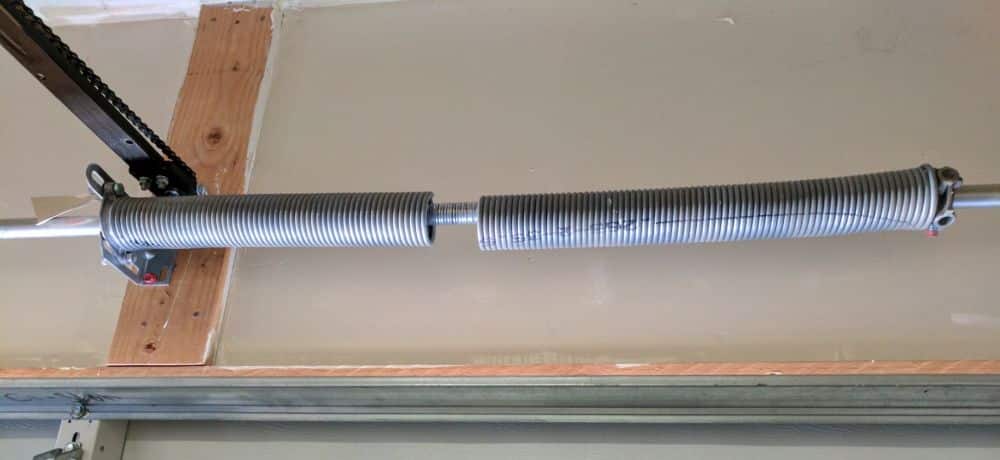Your garage door springs play a vital role in the functionality of your garage door, but have you ever wondered how long they last? In this comprehensive guide, we’ll delve into the lifespan of garage door springs, the factors influencing their longevity, and essential tips for maintenance.

Understanding the Lifespan:
The Crucial Role of Garage Door Springs
Garage door springs are the unsung heroes of your garage door system. They counterbalance the weight of the door, making it possible to open and close effortlessly. However, like any mechanical component, garage door springs have a finite lifespan influenced by various factors.
Exploring Factors Affecting Garage Door Spring Lifespan
1. Type of Spring
There are two main types of garage door springs: extension springs and torsion springs. Torsion springs are generally considered to have a longer lifespan than extension springs. Understanding the type of spring your garage door uses is crucial in estimating its potential lifespan.
2. Frequency of Use
The more frequently you use your garage door, the more wear and tear its springs will experience. A garage door that opens and closes multiple times a day will likely require spring replacement sooner than one with less frequent use.
3. Quality of the Springs
The quality of the garage door springs installed also plays a significant role in their lifespan. High-quality springs, made of durable materials, are likely to last longer than lower-quality alternatives. Investing in quality springs during installation can contribute to a more extended lifespan.
How Long Does a Garage Door Spring Last on Average?
1. Extension Springs
Extension springs typically last around 10,000 cycles. A cycle is counted each time the door opens and closes. For a garage door used twice a day, this translates to approximately 14 years.
2. Torsion Springs
Torsion springs generally have a longer lifespan, lasting between 15,000 and 20,000 cycles. This equates to roughly 20 years for a door opened and closed twice a day.
Signs of Worn-Out Garage Door Springs
1. Visible Wear and Tear
Inspect the springs regularly for any signs of wear and tear, including rust, gaps, or deformities. Visible damage indicates that the springs may be reaching the end of their lifespan.
2. Unusual Sounds*
A garage door with worn-out springs may produce unusual sounds during operation, such as creaking or grinding noises. These sounds can be indicative of spring issues and should not be ignored.
3. Imbalance in Door Movement*
If you notice an imbalance in your garage door’s movement, with one side rising faster than the other, it could be a sign of a failing spring. Addressing this issue promptly is crucial to prevent further damage to the door and other components.
How To Extend the Lifespan of Your Garage Door Springs
1. Regular Lubrication
Lubricate your garage door springs regularly to reduce friction and minimize wear. Use a silicone-based lubricant and apply it to the springs, hinges, and other moving parts.
2. Professional Maintenance*
Schedule professional maintenance for your garage door system at least once a year. A trained technician can inspect the springs, identify potential issues, and perform necessary adjustments or replacements.
3. Be Mindful of Weight Limits*
Avoid overloading your garage door with excessive weight. Know the weight limits specified by the manufacturer and refrain from storing heavy items on or near the door.
The Importance of Timely Replacement
Garage door springs, despite their crucial role, are not meant to last indefinitely. Timely replacement is essential to ensure the continued safe and efficient operation of your garage door.
The Consequences of Neglecting Spring Replacement
1. Safety Risks*
Worn-out garage door springs pose safety risks. A sudden failure of the springs can lead to the door falling unexpectedly, potentially causing injuries or property damage.
2. Additional Strain on the Opener*
If the springs are not functioning correctly, the garage door opener has to work harder to lift the door. This can lead to premature wear and tear on the opener, necessitating costly repairs or replacements.
3. Potential Damage to the Door*
Continued use of worn-out springs can result in additional stress on the garage door itself. This can lead to misalignments, warping, or other structural issues that may require extensive repairs.
Conclusion:
In conclusion, understanding how long a garage door spring lasts is crucial for homeowners seeking to maintain the functionality and safety of their garage doors. Regular inspection, timely replacement, and proactive maintenance are key practices that can significantly extend the lifespan of these essential components.
By staying informed about the factors influencing garage door spring longevity and recognizing the signs of wear and tear, you can ensure that your garage door operates smoothly and safely for years to come. Invest in the longevity of your garage door system, and you’ll enjoy the convenience and security it provides without unexpected interruptions.



Leave a Reply